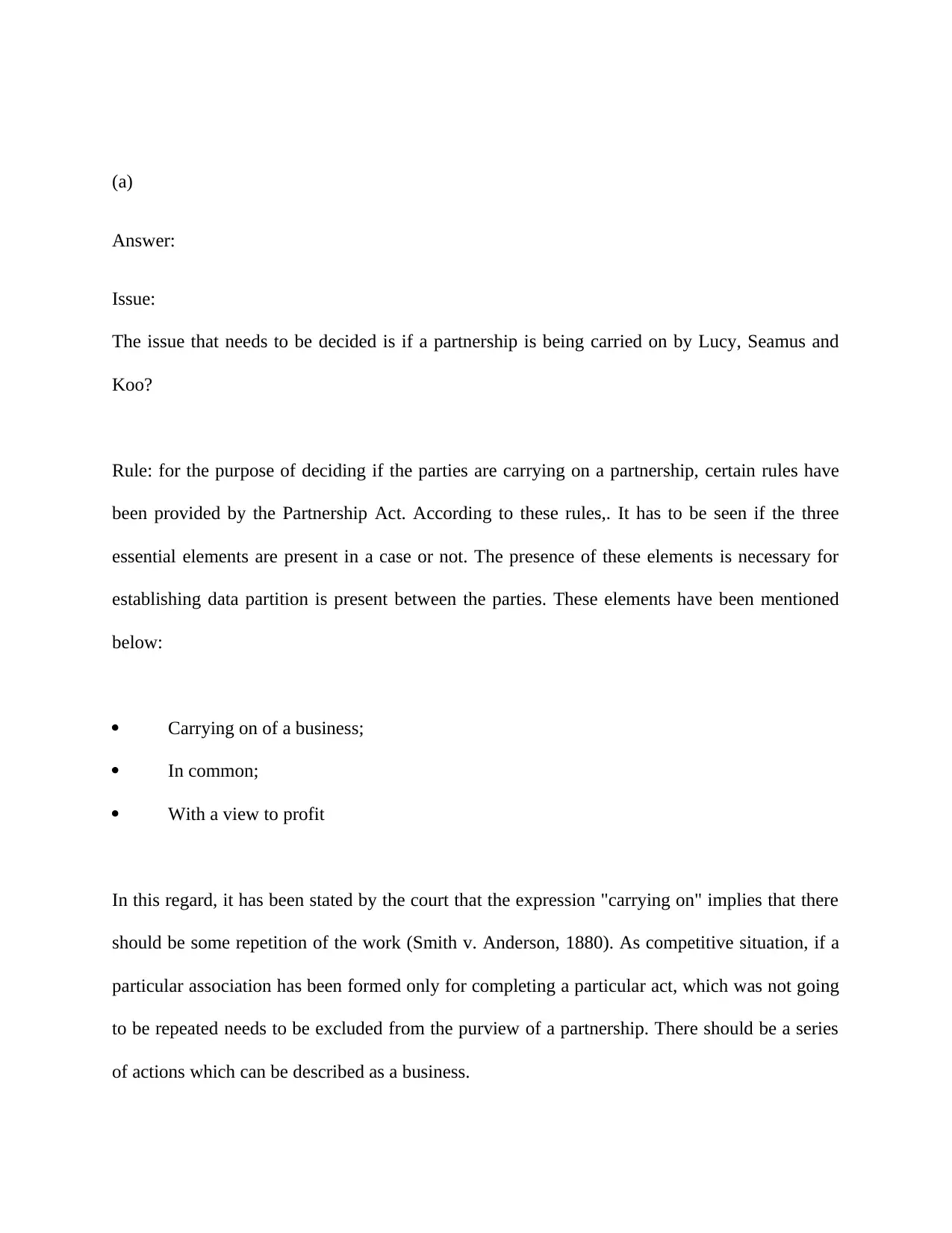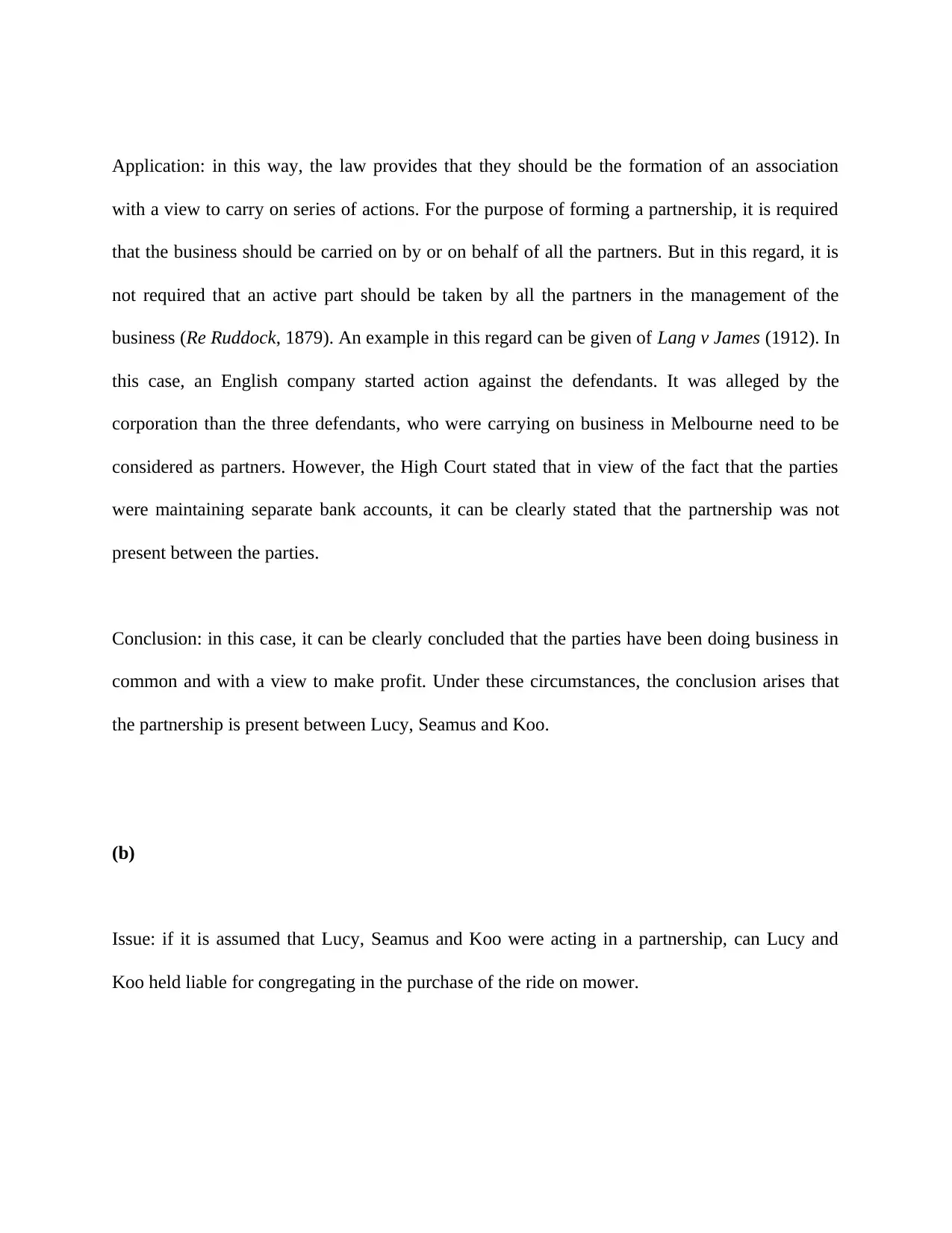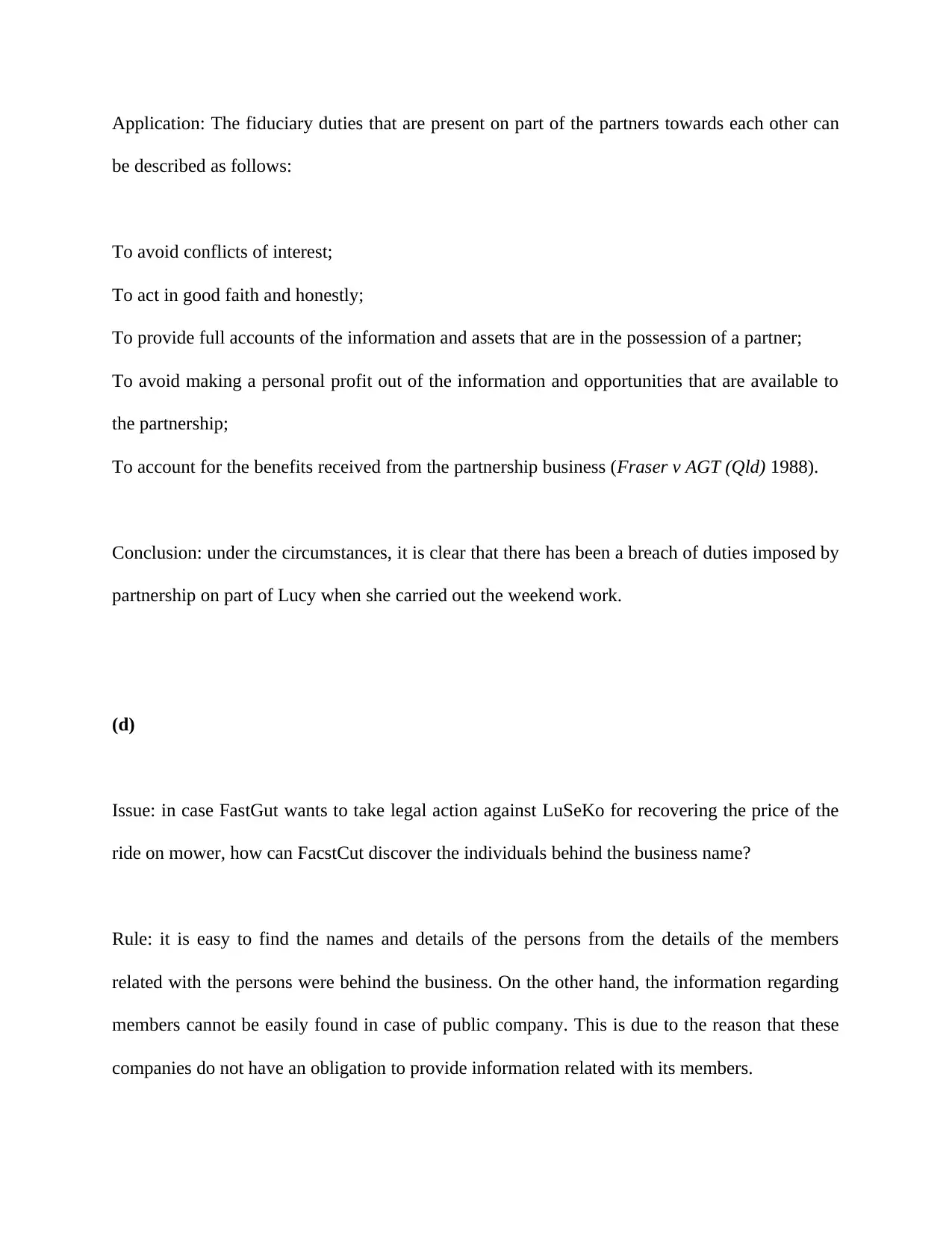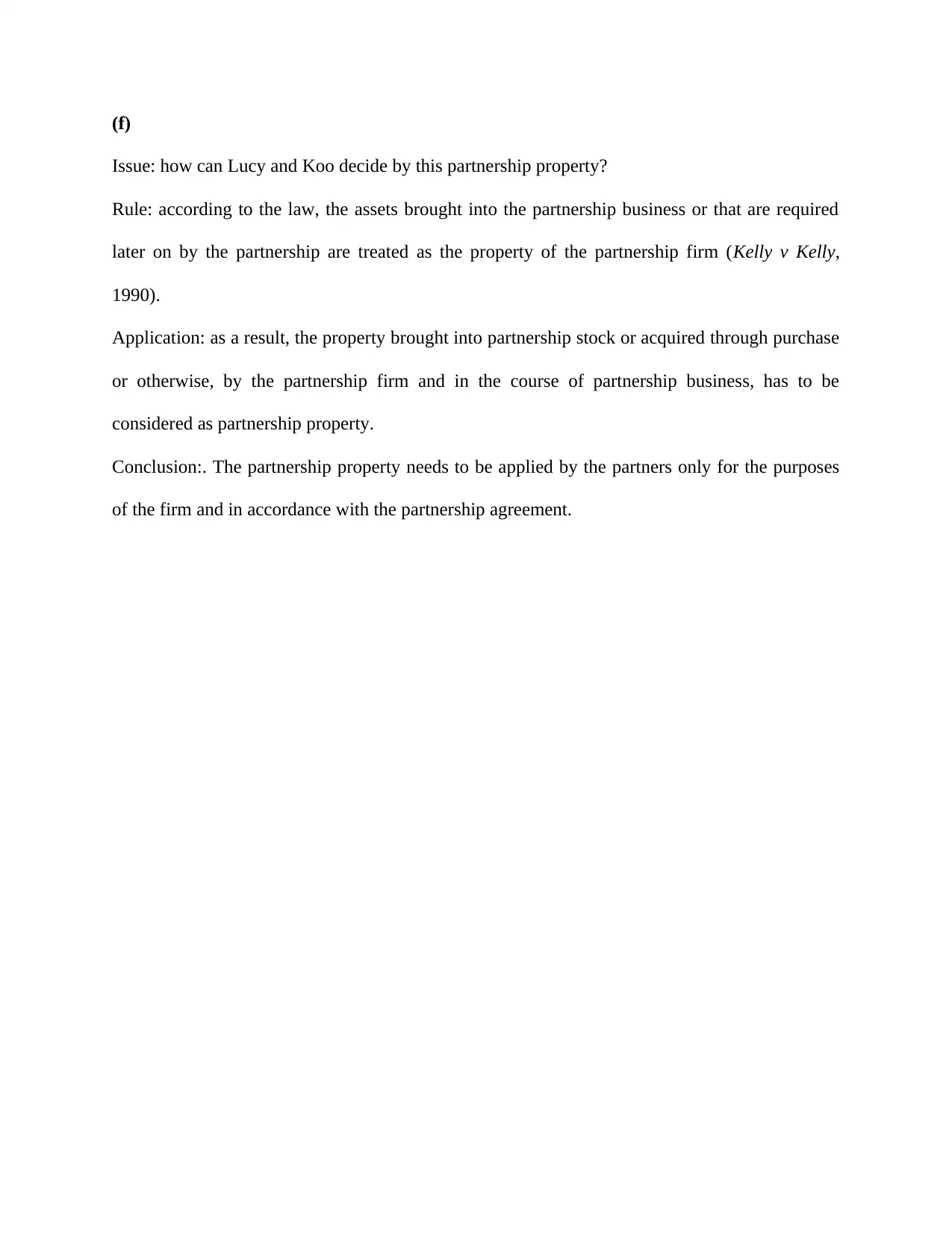Partnership Law: Analysis of Lucy, Seamus and Koo's Partnership
VerifiedAdded on 2023/06/04
|7
|1495
|316
AI Summary
This article provides an analysis of partnership law in relation to Lucy, Seamus and Koo's partnership. It covers issues such as partnership formation, liability, breach of duties, and partnership property.
Contribute Materials
Your contribution can guide someone’s learning journey. Share your
documents today.

(a)
Answer:
Issue:
The issue that needs to be decided is if a partnership is being carried on by Lucy, Seamus and
Koo?
Rule: for the purpose of deciding if the parties are carrying on a partnership, certain rules have
been provided by the Partnership Act. According to these rules,. It has to be seen if the three
essential elements are present in a case or not. The presence of these elements is necessary for
establishing data partition is present between the parties. These elements have been mentioned
below:
Carrying on of a business;
In common;
With a view to profit
In this regard, it has been stated by the court that the expression "carrying on" implies that there
should be some repetition of the work (Smith v. Anderson, 1880). As competitive situation, if a
particular association has been formed only for completing a particular act, which was not going
to be repeated needs to be excluded from the purview of a partnership. There should be a series
of actions which can be described as a business.
Answer:
Issue:
The issue that needs to be decided is if a partnership is being carried on by Lucy, Seamus and
Koo?
Rule: for the purpose of deciding if the parties are carrying on a partnership, certain rules have
been provided by the Partnership Act. According to these rules,. It has to be seen if the three
essential elements are present in a case or not. The presence of these elements is necessary for
establishing data partition is present between the parties. These elements have been mentioned
below:
Carrying on of a business;
In common;
With a view to profit
In this regard, it has been stated by the court that the expression "carrying on" implies that there
should be some repetition of the work (Smith v. Anderson, 1880). As competitive situation, if a
particular association has been formed only for completing a particular act, which was not going
to be repeated needs to be excluded from the purview of a partnership. There should be a series
of actions which can be described as a business.
Secure Best Marks with AI Grader
Need help grading? Try our AI Grader for instant feedback on your assignments.

Application: in this way, the law provides that they should be the formation of an association
with a view to carry on series of actions. For the purpose of forming a partnership, it is required
that the business should be carried on by or on behalf of all the partners. But in this regard, it is
not required that an active part should be taken by all the partners in the management of the
business (Re Ruddock, 1879). An example in this regard can be given of Lang v James (1912). In
this case, an English company started action against the defendants. It was alleged by the
corporation than the three defendants, who were carrying on business in Melbourne need to be
considered as partners. However, the High Court stated that in view of the fact that the parties
were maintaining separate bank accounts, it can be clearly stated that the partnership was not
present between the parties.
Conclusion: in this case, it can be clearly concluded that the parties have been doing business in
common and with a view to make profit. Under these circumstances, the conclusion arises that
the partnership is present between Lucy, Seamus and Koo.
(b)
Issue: if it is assumed that Lucy, Seamus and Koo were acting in a partnership, can Lucy and
Koo held liable for congregating in the purchase of the ride on mower.
with a view to carry on series of actions. For the purpose of forming a partnership, it is required
that the business should be carried on by or on behalf of all the partners. But in this regard, it is
not required that an active part should be taken by all the partners in the management of the
business (Re Ruddock, 1879). An example in this regard can be given of Lang v James (1912). In
this case, an English company started action against the defendants. It was alleged by the
corporation than the three defendants, who were carrying on business in Melbourne need to be
considered as partners. However, the High Court stated that in view of the fact that the parties
were maintaining separate bank accounts, it can be clearly stated that the partnership was not
present between the parties.
Conclusion: in this case, it can be clearly concluded that the parties have been doing business in
common and with a view to make profit. Under these circumstances, the conclusion arises that
the partnership is present between Lucy, Seamus and Koo.
(b)
Issue: if it is assumed that Lucy, Seamus and Koo were acting in a partnership, can Lucy and
Koo held liable for congregating in the purchase of the ride on mower.

Rule: The relevant rule in this regard has been provided by section 9 of the Partnership Act. In
this unit has been stated that under the law, each partner is considered as being jointly liable for
the debts of the firm if these obligations were incurred at a time when such person was a partner.
Similarly, after the death of such person, the estate of the partner can be held severally liable for
the debts of the firm.
Application: under these circumstances, in view of the joint liability of all the partners of the
firm, even if such liability as the incurred by two or more persons, only one type of engine is
available against these persons. As a result, in case the judgment has been obtained against a
partner or the partners, further legal action can be initiated only against the partners who can be
held jointly liable as if there were also a part of the action.
Conclusion as a result of the legal rules mentioned above, in this case, it can be concluded that
Lucy and Koo are also liable to before the ride on mower.
(c)
Issue: the issue in this part of the question is if there has been a breach of partnership duties due
to the carrying on of the weekend work?
Rule: the partnership law provides that the relationship between the partners is fiduciary in
nature. Consequently, it has been stated in Birtchnell v Equity Trustees (1929) that that the
relationship of partnership is of fiduciary nature. A presumption present under the law according
to which partnership is based on mutual trust that exists between the partners, as well as the
confidence of the partners in the integrity of each other (Cameron v Murdoch, 1986).
this unit has been stated that under the law, each partner is considered as being jointly liable for
the debts of the firm if these obligations were incurred at a time when such person was a partner.
Similarly, after the death of such person, the estate of the partner can be held severally liable for
the debts of the firm.
Application: under these circumstances, in view of the joint liability of all the partners of the
firm, even if such liability as the incurred by two or more persons, only one type of engine is
available against these persons. As a result, in case the judgment has been obtained against a
partner or the partners, further legal action can be initiated only against the partners who can be
held jointly liable as if there were also a part of the action.
Conclusion as a result of the legal rules mentioned above, in this case, it can be concluded that
Lucy and Koo are also liable to before the ride on mower.
(c)
Issue: the issue in this part of the question is if there has been a breach of partnership duties due
to the carrying on of the weekend work?
Rule: the partnership law provides that the relationship between the partners is fiduciary in
nature. Consequently, it has been stated in Birtchnell v Equity Trustees (1929) that that the
relationship of partnership is of fiduciary nature. A presumption present under the law according
to which partnership is based on mutual trust that exists between the partners, as well as the
confidence of the partners in the integrity of each other (Cameron v Murdoch, 1986).

Application: The fiduciary duties that are present on part of the partners towards each other can
be described as follows:
To avoid conflicts of interest;
To act in good faith and honestly;
To provide full accounts of the information and assets that are in the possession of a partner;
To avoid making a personal profit out of the information and opportunities that are available to
the partnership;
To account for the benefits received from the partnership business (Fraser v AGT (Qld) 1988).
Conclusion: under the circumstances, it is clear that there has been a breach of duties imposed by
partnership on part of Lucy when she carried out the weekend work.
(d)
Issue: in case FastGut wants to take legal action against LuSeKo for recovering the price of the
ride on mower, how can FacstCut discover the individuals behind the business name?
Rule: it is easy to find the names and details of the persons from the details of the members
related with the persons were behind the business. On the other hand, the information regarding
members cannot be easily found in case of public company. This is due to the reason that these
companies do not have an obligation to provide information related with its members.
be described as follows:
To avoid conflicts of interest;
To act in good faith and honestly;
To provide full accounts of the information and assets that are in the possession of a partner;
To avoid making a personal profit out of the information and opportunities that are available to
the partnership;
To account for the benefits received from the partnership business (Fraser v AGT (Qld) 1988).
Conclusion: under the circumstances, it is clear that there has been a breach of duties imposed by
partnership on part of Lucy when she carried out the weekend work.
(d)
Issue: in case FastGut wants to take legal action against LuSeKo for recovering the price of the
ride on mower, how can FacstCut discover the individuals behind the business name?
Rule: it is easy to find the names and details of the persons from the details of the members
related with the persons were behind the business. On the other hand, the information regarding
members cannot be easily found in case of public company. This is due to the reason that these
companies do not have an obligation to provide information related with its members.
Secure Best Marks with AI Grader
Need help grading? Try our AI Grader for instant feedback on your assignments.

Application: the register business name can be described as the trading name under which the
person or the persons on carrying on business or trade.
Conclusion , in this case, FastCut can easily find the persons who are behind the business name
from the business name register. This information is required by FastCut for the purpose of
initiating legal action against LuSeCo. In order to recover the price of the ride on mower.
(e)
Issue: the effect of Seamus' death on partnership"
Rule: according to the law partnership in case of the death of a partner, the partnership comes to
an end, unless any agreement to the contrary has been created between the parties. Due to this
reason, unless an agreement has been made by the parties which provide that the partnership will
continue even in case of the death of a partner, the general partnership is resolved, whenever the
death of a partner takes place (Everingham v Everingham, 1911).
Application: in such a case, if the rest of the partners who are willing to carry on the partnership
business after it has been dissolved should agree. But in such a case the partnership business will
be treated by the law as a new partnership.
Conclusion: it can be stated that in the event of the death of Seamus, the partnership will
automatically come to an end.
person or the persons on carrying on business or trade.
Conclusion , in this case, FastCut can easily find the persons who are behind the business name
from the business name register. This information is required by FastCut for the purpose of
initiating legal action against LuSeCo. In order to recover the price of the ride on mower.
(e)
Issue: the effect of Seamus' death on partnership"
Rule: according to the law partnership in case of the death of a partner, the partnership comes to
an end, unless any agreement to the contrary has been created between the parties. Due to this
reason, unless an agreement has been made by the parties which provide that the partnership will
continue even in case of the death of a partner, the general partnership is resolved, whenever the
death of a partner takes place (Everingham v Everingham, 1911).
Application: in such a case, if the rest of the partners who are willing to carry on the partnership
business after it has been dissolved should agree. But in such a case the partnership business will
be treated by the law as a new partnership.
Conclusion: it can be stated that in the event of the death of Seamus, the partnership will
automatically come to an end.

(f)
Issue: how can Lucy and Koo decide by this partnership property?
Rule: according to the law, the assets brought into the partnership business or that are required
later on by the partnership are treated as the property of the partnership firm (Kelly v Kelly,
1990).
Application: as a result, the property brought into partnership stock or acquired through purchase
or otherwise, by the partnership firm and in the course of partnership business, has to be
considered as partnership property.
Conclusion:. The partnership property needs to be applied by the partners only for the purposes
of the firm and in accordance with the partnership agreement.
Issue: how can Lucy and Koo decide by this partnership property?
Rule: according to the law, the assets brought into the partnership business or that are required
later on by the partnership are treated as the property of the partnership firm (Kelly v Kelly,
1990).
Application: as a result, the property brought into partnership stock or acquired through purchase
or otherwise, by the partnership firm and in the course of partnership business, has to be
considered as partnership property.
Conclusion:. The partnership property needs to be applied by the partners only for the purposes
of the firm and in accordance with the partnership agreement.

References
Birtchnell v Equity Trustees, Executors and Agency Co Ltd (1929) 42 CLR 384
Cameron v Murdoch (1986) 63 ALR 575
Fraser Edmiston Pty Ltd v AGT (Qld) Pty Ltd [1988] 2 Qd R 1
Kelly v Kelly (1990) 92 ALR 74
Lang v James Morrison & Co Ltd (1912) 13 CLR 1
Re Ruddock (1879) 5 VLR (IP & M) 51
Smith v Anderson (1880) 15 Ch D 247
Birtchnell v Equity Trustees, Executors and Agency Co Ltd (1929) 42 CLR 384
Cameron v Murdoch (1986) 63 ALR 575
Fraser Edmiston Pty Ltd v AGT (Qld) Pty Ltd [1988] 2 Qd R 1
Kelly v Kelly (1990) 92 ALR 74
Lang v James Morrison & Co Ltd (1912) 13 CLR 1
Re Ruddock (1879) 5 VLR (IP & M) 51
Smith v Anderson (1880) 15 Ch D 247
1 out of 7
Related Documents
Your All-in-One AI-Powered Toolkit for Academic Success.
+13062052269
info@desklib.com
Available 24*7 on WhatsApp / Email
![[object Object]](/_next/static/media/star-bottom.7253800d.svg)
Unlock your academic potential
© 2024 | Zucol Services PVT LTD | All rights reserved.





